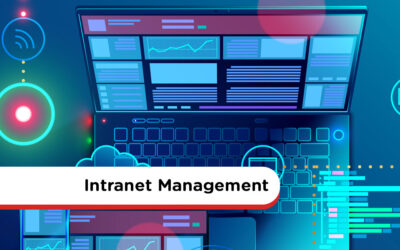The Intranet Design Guide
Not sure where to get started in designing your intranet?
Check out our easy step-by-step guide below.
Let us guide you through the process.

Intranet Design Made Simple
Deciding to go ahead with an intranet was the easy part, right? After all, whether it’s improved communications, more streamlined processes, or easier access to information, the intranet ticks all the boxes.
However, designing your intranet can be a daunting task.
There are many decisions to be made around the type of intranet, hosting options, organization, structure, plus content, and design. With so much to think about, it can be tough to get started.
And if technology isn’t really your thing, it can be even harder to kick-start your intranet. That’s where this intranet design guide comes into play.
So, if widget, cache, and malware sound like another language, then this guide is for you! Written in simple-to-understand and jargon-free terms, the design guide is non-technical. And where technical language is unavoidable, we clearly define what we mean.
This guide will show you that designing an intranet is a simple task. In fact, it’s so easy, you won’t need IT backup or a college degree in computers!
Click here to download this guide in PDF format
Step-By-Step Intranet Design Support
The guide is a comprehensive resource, covering everything you need to know about intranets. We provide helpful insights at every stage, from different intranet types and hosting options to security and training.
And we also look at all the latest intranet design best practices. This resource includes lots of practical examples and visuals that will excite and inspire you.
What’s Included In This Intranet Design Guide
Who Should Read This Guide
The design guide is an essential resource for anyone planning to implement a new intranet. It’s also required reading if you are looking to revitalize, revamp, or refresh an existing intranet.
Perhaps you are in the market for an intranet provider to help you realize your vision. The design guide can help you make a winning selection.
Written for the non-technical person, this resource will also support HR or Marketing staff tasked with implementing an intranet.
Why Intranet Design Is So Important
Before we move on, it’s essential to understand why intranet design is so important.
Your intranet’s overall look and feel has the power to grab users’ attention and draw them in. It can spark creativity and foster collaboration. It can connect employees and turn the everyday task into something engaging and fun.
However, the stakes are high. A poorly designed intranet will have the opposite effect. A confusing, overloaded, and ugly intranet will see staff switch off. It’s a wasted opportunity as well as investment.
With so much to lose, getting your intranet design right has to be a priority.
No Two Intranets Are Alike
When it comes to design, there is no one-size-fits-all intranet solution. Sure, there will be similarities. It could be layout, functionality, or scope. However, every organization is different, and so too is their intranet.
Furthermore, staff members will use the intranet differently depending on their job roles and team functions.
Employees use the intranet mainly to source information or collaborate with colleagues. Managers, however, use the intranet to engage workers with targeted communications.
Your intranet design needs to satisfy all the varying needs of employees.
And it also needs to meet the challenges of the modern digital workplace.
The global Covid-19 pandemic has fast-tracked the shift towards remote working. Companies have to pivot and rethink how they engage with their workforce in today’s rapidly changing environment.
And they need to ensure employees have the tools available to remain productive even when working from home.
A mobile intranet is a minimum requirement. In fact, it’s not so much a requirement as an expectation. Whether staff are on the go or working from home, they expect to continue working.
Versatile and flexible, the intranet is capable of meeting these competing demands. And your intranet design should make this vision a reality.
Intranet Templates Make Design Easy
And if you are pushed for time, then intranet design templates could be the perfect solution. This guide takes you through all you need to know.
In short, intranet templates come with in-built coding plus a basic design and graphics. The setup wizard makes it quick and easy to implement your customized intranet. Upload your logo, branding, and corporate colors to really put your company stamp on the intranet. And the good news is the intranet provider has already extensively tested the functionality. And that’s one less major headache for you to worry about.
Therefore, design templates are a popular choice if you need to get your intranet up and running quickly.
Let Us Guide You
Use this guide to make your intranet deployment a smoother and quicker process.
Essential reading for those starting to deploy an intranet, this resource will also help businesses looking to revamp an existing intranet.
Either way, we understand the challenges that are involved. And you get the benefit of our experience as we guide you through the process from beginning to end.
So, let’s get started.
Intranet Design Infographic
If you would like an overview of our intranet design guide, we have created a PDF infographic file summarizing the main points available here.
Further Reading
This further reading list will be an invaluable resource as it takes you through everything you need to know. We give you the benefit of our considerable experience in developing intranets and provide simple, easy-to-follow explanations, insights and advice.
Use this list to explore the latest intranet design best practice principles. Find out how pre-built intranet templates could well be the solution every time-pressed business owner is looking for. Discover how to ensure your intranet design is mobile friendly and optimized for use on smartphones and tablets. And learn about how to make your intranet interactive and fun so that users readily engage with the platform making for a more efficient and effective workplace.
These are just some of the insights available in this category so why not have a browse or use the search functionality to explore more about intranet design. With our comprehensive knowledge bank, you’ll soon discover that designing an intranet isn’t the mammoth task that perhaps you first thought it was.
Employee Engagement – The Ultimate Definition
Employee engagement is more than just a buzzword; it’s a critical component of organizational success. Defined as the emotional commitment an employee has towards their organization and its goals, engagement drives individuals to go above and beyond their basic job responsibilities. Engaged employees are not only more productive but also contribute to a positive workplace culture and higher retention rates.
It’s essential to distinguish employee engagement from related concepts like satisfaction and happiness. While a satisfied employee may be content with their job, they might not be emotionally invested in the company’s mission. Similarly, a happy employee enjoys their work environment but isn’t necessarily driven to contribute beyond their duties. True engagement combines satisfaction, happiness, and a deep-seated commitment to the organization’s success.
To cultivate employee engagement, organizations should focus on clear communication, recognition of achievements, opportunities for professional growth, and fostering a sense of purpose among employees. Implementing these strategies can lead to a more motivated workforce, improved performance, and a competitive edge in today’s dynamic business landscape.
Top 10 Internal Communication Examples
Effective internal communication is the backbone of a cohesive and productive organization. In the evolving landscape of remote and hybrid work environments, companies must adopt innovative communication strategies to keep teams aligned and engaged. This blog post highlights ten exemplary internal communication practices that organizations can implement to enhance collaboration and transparency.
From visible leadership through regular updates to utilizing instant messaging for agile decision-making, these examples showcase how companies like Starbucks, Netflix, and Coca-Cola have successfully fostered open communication channels. By embracing tools such as internal podcasts, employee surveys, and dedicated intranet spaces, these organizations have created environments where employees feel heard and valued.
Implementing these internal communication strategies can lead to increased employee satisfaction, reduced turnover, and improved overall performance. By learning from these real-world examples, businesses can tailor their communication approaches to meet the unique needs of their teams and drive organizational success.
Top 30 Employee Engagement Videos
Employee engagement is crucial for organizational success, directly impacting productivity, morale, and retention. In today’s hybrid and remote work environments, maintaining high levels of engagement presents unique challenges. Video content has emerged as a powerful tool to bridge communication gaps, offering a personal and authentic way to connect with employees.
Recognizing the abundance of available content, MyHub Intranet has curated a list of the top 30 employee engagement videos. These selections cover various topics, including foundational concepts, managerial strategies, and innovative approaches to boost engagement. Each video is chosen for its relevance, clarity, and potential to inspire actionable change within organizations.
Whether you’re an HR professional, team leader, or business owner, these videos serve as valuable resources to understand and implement effective engagement strategies. By leveraging visual content, organizations can foster a more connected, motivated, and productive workforce.
10 Employee Appreciation Ideas On A Budget
Employee appreciation is a powerful tool for boosting morale, increasing engagement, and reducing turnover. However, many organizations believe that meaningful recognition requires a significant financial investment. In reality, small, thoughtful gestures can have a profound impact on employee satisfaction.
Implementing budget-friendly appreciation strategies, such as personalized thank-you notes, shout-outs during team meetings, or organizing casual lunch gatherings, can make employees feel valued without straining the company’s finances. These actions not only acknowledge individual contributions but also foster a culture of recognition within the organization.
By integrating regular appreciation practices into the workplace, companies can cultivate an environment where employees feel respected and motivated. This approach leads to improved performance, higher retention rates, and a more positive organizational culture.
Stereotypes Of Millennials – What Employers Need To Know
Millennials, often defined as individuals born between 1981 and 1996, have become a significant demographic in today’s workforce. However, they are frequently subjected to stereotypes that paint them as entitled, lazy, or overly reliant on technology. These misconceptions can lead to misunderstandings and missed opportunities for employers seeking to engage and retain Millennial talent.
In reality, Millennials are characterized by their adaptability, tech-savviness, and desire for meaningful work. They value flexibility, continuous learning, and work-life balance. Contrary to the stereotype of job-hopping, many Millennials seek long-term career growth and are committed to organizations that align with their values.
For employers, it’s crucial to move beyond generational stereotypes and recognize the diverse strengths Millennials bring to the workplace. By fostering an inclusive environment that supports their professional development and well-being, organizations can harness the full potential of this dynamic generation.
Intranet Management Best Practices
Launching an intranet is a significant step toward improving internal communication and collaboration within an organization. However, the true measure of success lies in how effectively the intranet is managed post-launch. A well-maintained intranet requires a clear strategy encompassing content governance, user management, analytics, and ongoing training to remain a valuable asset.
Effective information management is at the heart of a successful intranet. This involves developing a comprehensive content strategy that outlines goals, structures content logically, and establishes clear publishing workflows. Regular content audits, version control, and the use of content calendars ensure that information remains current and relevant, thereby maintaining user trust and engagement.
User management is equally critical, involving the assignment of appropriate permissions, management of user access, and ensuring data security. Analytics play a pivotal role in measuring intranet performance, providing insights into user engagement and content effectiveness. Additionally, continuous onboarding and training programs are essential to equip employees with the necessary skills to utilize the intranet effectively, fostering a culture of collaboration and knowledge sharing.
SOP Intranet Benefits: Simplify, Standardize, and Stay Compliant
Standard Operating Procedures (SOPs) are essential for maintaining consistency, ensuring compliance, and preserving organizational knowledge. However, managing SOPs can be cumbersome, especially when dealing with numerous documents across various departments. The blog post from MyHub Intranet highlights how a company intranet can revolutionize SOP management by centralizing documents, streamlining updates, and enhancing accessibility.
By housing all SOPs within a centralized intranet platform, organizations can ensure that employees have access to the most current procedures anytime, anywhere. This 24/7 accessibility is particularly beneficial for remote workers and those in the field, reducing downtime and improving operational efficiency. Additionally, the intranet’s intuitive navigation and advanced search capabilities make it easy for staff to locate relevant SOPs quickly.
Furthermore, integrating SOPs with automated forms and compliance tracking within the intranet fosters a culture of accountability and continuous improvement. Employees can confidently rely on the intranet as the single source of truth, minimizing errors caused by outdated information. Overall, leveraging a company intranet for SOP management not only simplifies administrative processes but also reinforces compliance and supports effective knowledge transfer.
8 Performance Review Tips For Employees
Performance reviews are pivotal moments in an employee’s career, offering opportunities for reflection, feedback, and future planning. The blog post from MyHub Intranet provides eight actionable tips to help employees navigate these evaluations with confidence. By gathering relevant information, such as job descriptions and past objectives, employees can present a comprehensive view of their contributions and growth over the review period.
A key recommendation is the completion of a self-appraisal, encouraging individuals to assess their strengths, weaknesses, opportunities, and threats. This introspective approach not only prepares employees for potential discussions during the review but also demonstrates initiative and self-awareness. Additionally, drafting a preliminary list of goals showcases foresight and a commitment to continuous improvement.
The article emphasizes that performance reviews should be seen as collaborative dialogues rather than one-sided evaluations. By approaching the review with preparation and a proactive mindset, employees can engage in meaningful conversations about their career trajectories, seek constructive feedback, and align their personal goals with organizational objectives.
IT Intranet: How To Improve Service And Boost Your Profile
In today’s digital workplace, IT departments play a pivotal role in ensuring seamless operations. However, their contributions often go unnoticed until issues arise. The blog post from MyHub Intranet emphasizes the importance of leveraging an IT intranet to enhance service delivery and boost the department’s internal profile. By integrating automated helpdesk workflows, IT teams can efficiently manage support requests, ensuring timely resolutions and improved user satisfaction.
Furthermore, the article highlights the value of creating a centralized knowledge hub within the intranet. This repository allows employees to access self-service resources, such as troubleshooting guides and how-to videos, reducing dependency on IT staff for routine queries. Additionally, IT professionals can utilize the platform to store internal documentation, project updates, and strategic plans, fostering better collaboration and information sharing within the team.
Effective communication is another critical aspect addressed in the blog. The IT intranet serves as a reliable channel for disseminating important announcements, system updates, and maintenance schedules. By utilizing targeted notifications and instant messaging features, IT departments can ensure that all employees are promptly informed, minimizing disruptions and enhancing overall operational efficiency.
Keep The Peace: 20 Tips To Overcome Remote Team Conflict
In the era of remote work, conflicts within virtual teams are increasingly common due to factors like miscommunication and lack of non-verbal cues. The blog post from MyHub Intranet outlines 10 actionable strategies to help teams navigate and resolve conflicts effectively. These tips emphasize the importance of clear communication, setting expectations, and fostering a culture of trust and respect.
The article highlights the necessity of using appropriate communication tools to bridge the gap left by the absence of face-to-face interactions. It also stresses the value of regular check-ins and feedback sessions to address issues promptly before they escalate. By implementing these strategies, teams can create a supportive environment that encourages open dialogue and collaboration.
Furthermore, the blog discusses the role of leadership in conflict resolution. Leaders are encouraged to model positive behaviors, mediate disputes impartially, and provide guidance on resolving disagreements constructively. By adopting these practices, remote teams can enhance their cohesion and maintain a harmonious working environment.
How to Save Paper: 12 Easy Tips for Efficiency and Sustainability
In today’s digital age, reducing paper usage is not only an eco-friendly choice but also a smart business strategy. The blog post from MyHub Intranet outlines 12 practical tips to help organizations minimize paper waste, cut costs, and improve operational efficiency. These strategies include transitioning to digital approval forms, implementing electronic document storage, and adopting cloud-based collaboration tools.
The article emphasizes the importance of rethinking traditional paper-based processes. By embracing digital solutions, businesses can streamline workflows, reduce the risk of errors, and enhance data security. The shift towards paperless operations also aligns with growing consumer expectations for environmental responsibility, making it a crucial step for companies aiming to build a sustainable brand image.
Moreover, the blog highlights the financial benefits of reducing paper consumption. Organizations can save on printing costs, reduce the need for physical storage space, and lower maintenance expenses associated with paper-based systems. Overall, the post provides a comprehensive guide for businesses looking to adopt more sustainable and efficient practices.
Employee Suggestion Program: How To Find The Gold
The blog post emphasizes the untapped potential within employee suggestions, citing examples like Amazon Prime and the Facebook ‘Like’ button, which originated from staff ideas. Employees, being on the front lines, possess unique insights that can lead to significant innovations and improvements. Encouraging a culture where these ideas are welcomed can be a game-changer for businesses.
Implementing a digital employee suggestion program via an intranet simplifies the process of capturing and evaluating ideas. Best practices include creating easy-to-use submission forms, allowing multimedia attachments, and categorizing suggestions to align with business goals. Automated workflows ensure that ideas are directed to the appropriate personnel, and contributors receive timely feedback, fostering transparency and trust.
Beyond the suggestion box, the article explores additional avenues like employee forums, focus groups, pulse surveys, and instant messaging channels to gather feedback. The key takeaway is to create an environment where all ideas are valued, provide clear guidelines, and ensure consistent communication about the outcomes of suggestions. By doing so, organizations can cultivate a continuous improvement culture that leverages employee creativity.
How To Deliver Bad News To Employees
Delivering bad news to employees is one of the most challenging tasks managers face, especially during times of economic uncertainty. The blog post emphasizes the importance of preparation, suggesting that managers anticipate potential questions and have clear, honest answers ready. Choosing the right time and setting for the conversation is crucial to ensure the message is received with the intended sensitivity.
The article advises against sugar-coating the message. Instead, managers should be direct and transparent, providing a clear explanation of the reasons behind the decision. It’s essential to allow employees space to process the information, express their emotions, and ask questions. Demonstrating empathy and understanding during this process can help maintain trust and respect.
Furthermore, the blog highlights the importance of supporting the remaining team members after delivering bad news. Open communication channels, such as discussion forums or surveys, can help gauge employee sentiment and address concerns promptly. By handling difficult conversations with care and transparency, managers can navigate challenging situations while preserving team cohesion and morale.
Salesforce Intranet: Save Money With A Winning Combination
Integrating Salesforce with your company’s intranet offers a powerful solution to enhance internal communication and collaboration. By centralizing access to Salesforce data within the intranet, employees can seamlessly retrieve customer information, track sales activities, and manage tasks without switching between platforms. This integration not only improves efficiency but also ensures that teams are aligned and informed.
The blog post delves into the cost-saving benefits of this integration. By reducing the need for multiple software licenses and minimizing training requirements, organizations can allocate resources more effectively. Additionally, the streamlined workflows lead to faster decision-making and improved customer service, further contributing to the bottom line.
MyHub Intranet provides practical guidance on implementing this integration, highlighting best practices and potential challenges. With the right approach, businesses can leverage the combined power of Salesforce and their intranet to drive productivity and achieve strategic goals.
Intranet Roadmap: How To Get Started On Your Intranet Project
Implementing a new intranet can be a daunting task, but with a well-structured roadmap, the process becomes manageable and efficient. An intranet roadmap serves as a strategic plan that outlines the vision, objectives, and key milestones of the project. It ensures all stakeholders are aligned and provides clarity on the steps needed for successful implementation.
The roadmap typically includes elements such as the overall vision, important milestones, specific workstreams like intranet design and content generation, a timeline for implementation, and success measures. It also emphasizes the importance of involving various departments, such as marketing and HR, to contribute to content creation and employee training. By breaking down the project into manageable pieces, the roadmap facilitates better internal communication and collaboration.
MyHub Intranet Solutions
MyHub’s guide provides practical insights into creating an intranet roadmap, including tips on setting clear objectives, involving a steering group, and identifying a project owner. It also discusses the benefits of cloud-based intranet solutions, which are easy to set up, cost-effective, and require minimal technical knowledge. With a well-planned roadmap, organizations can ensure a smooth intranet implementation that meets their specific needs.
















